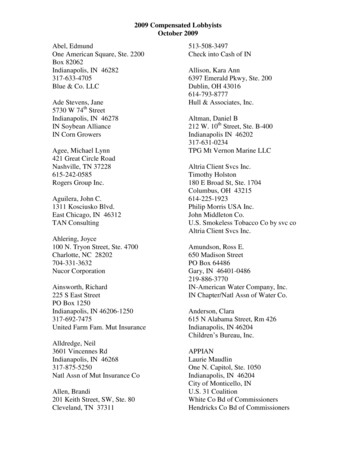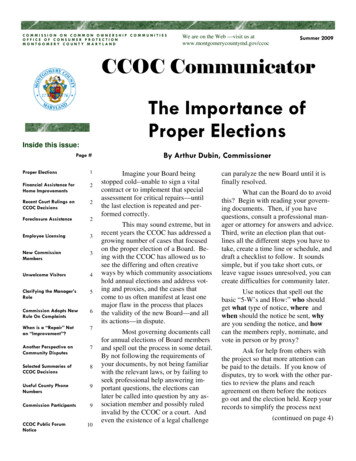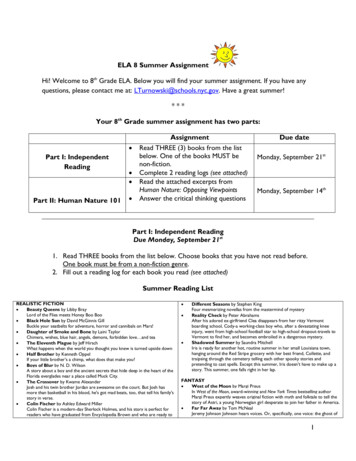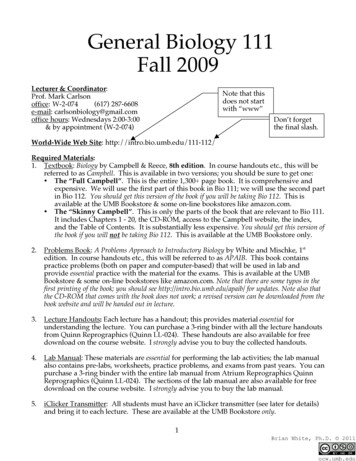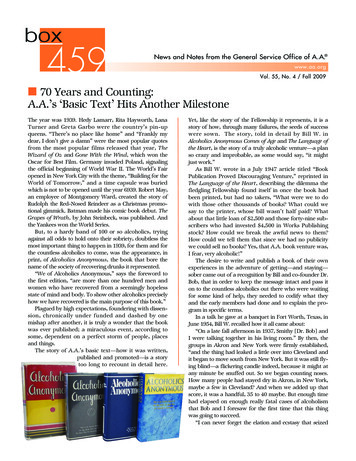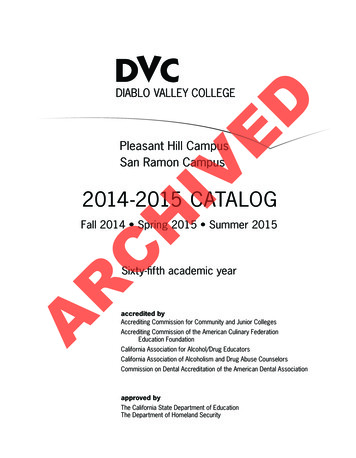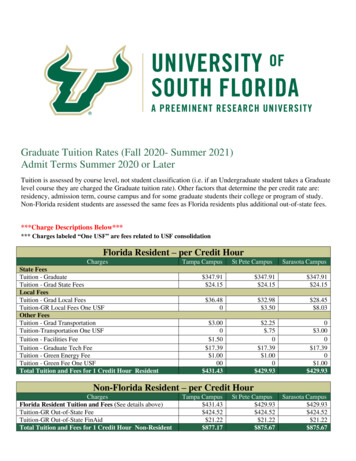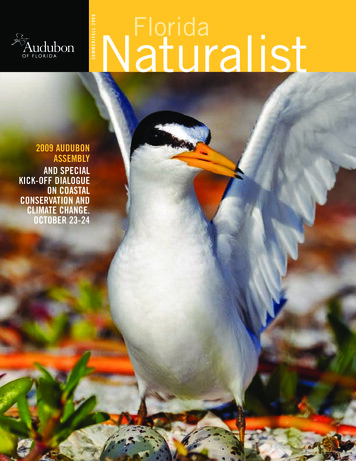
Transcription
SUMMER/FALL 20092009 AUDUBONASSEMBLYAND SPECIALKICK-OFF DIALOGUEON COASTALCONSERVATION ANDCLIMATE CHANGE.OCTOBER 23-24FloridaNaturalist
2009Board of DirectorsJohn Hankinson, Jr., ChairmanCreative Solutions for the EnvironmentJ. T. Ambrozy, Vice ChairmanPhilanthropistJohn Robert Middlemas, Vice ChairmanNorthwest RegionJohn F. Flanigan, Esq., Immediate PastChairmanMoyle, Flanigan, Katz, Raymnd & SheehanJohn Sorey, Board SecretaryManagement Support Systems, Inc.Christine Andrews, Ph.D., Board TreasurerSanibel Captiva Audubon SocietyRichard Gragg, Ph.D., Asst. SecretaryFlorida A&M University EnvironmentalSciences InstituteSandy BatchelorThe Batchelor Foundation, Inc.Fred BennettLykes Brothers, Inc.Ernie CaldwellCentral RegionMissy ChristieVenice Area Audubon SocietyHenry DeanFormer Executive Director,South Florida Water Management DistrictJohn W. EltingNaturalist and philanthropistCharles GeanangelLake Region Audubon SocietyDave KandzSt. Petersburg Audubon Society,Gulf Coast RegionRandy LaBauveFlorida Power & Light Co.Carlos Lacasa, Esq.Everglades RegionNeil J. Lamb, Ph.D.Bay County Audubon SocietyStuart Langton, Ph.D.Stuart Langton and AssociatesSheri Ford LewinEnvironmental Resource MarketingWest McCannNorthern Trust BankAnn MooreMember at LargeDoug Pitts, Sr.Courtelis CompanyCynthia PlockelmanAudubon Society of the EvergladesDiane ReedSt Johns County Audubon SocietyDoug SantoniRoyal Caribbean Cruises Ltd.Michael SheridanFringe Benefits Management CompanyKatie SproulBarron Collier CompaniesAndy Stamper, DMVDisney’s Animal ProgramsBarbara Sheen ToddGulf Coast RegionDoug Warns, Ph.D.Audubon of Martin CountyGeorge W. WillsonWillson Consulting, LLCEXECUTIVE DIRECTOR’S MESSAGENothing defines Florida as well as our remarkable coastal areas. The atlas says thatFlorida has 1,197 miles of coastline, but that number masks the variety and diversityof these special places, from the white dunes of the Panhandle to the rocky shores ofthe Keys. The number is higher when you add tidal areas such as the landward sidesof barrier islands.Coastal areas are special to me because they are great places for bird watching. Whetherpicking out migrating hawks or spotting warblers in a maritime hammock, I know I amgoing to be treated to lots of bird species. Every generalization belies the randomuniqueness of our coasts, and each distinctive part is remarkable in its own way.Whether your favorite natural place in Florida has a view of the sun rising or the sunsetting, it is special because of what you experienced. The fish you caught, the birdyou saw, the people you were with, the smell of the air—these details bind us to thethousands of beautiful places where land meets water. We call this collective experience—of nature, time, and space—Florida. And Florida really is as much an experienceas a place. This is nowhere truer than along our coasts.We must all think about Florida’s coasts as an experience, because they are changing.The changes are not just winter moving into spring. Our changing climate is alteringFlorida’s coasts and impacting the species that depend on these habitats. Immediatechanges, such as the northeaster that stripped away so many Atlantic beaches earlierthis year, are coupled with long-term sea level rise that will impact beaches, saltmarshes, myriad coastal habitats and the birds that depend on them.Audubon is asking the question that must be answered by science, policy, andthoughtful action. How do we adapt to a changing coastline that both provideshabitat for numerous important species and hosts a built environment worthhundreds of billions of dollars?I invite you to join me at the 2009 Audubon Assembly on October 23 and 24 in St.Petersburg where this question and others will be discussed by experts, policy makers,scientists and concerned conservation leaders. The answers ultimately will come fromthose of us who value every changing mile our state’s shoreline.DDavidid AAndersondExecutive Director, Audubon of Florida
AUDUBON’S RESOLVEREMAINS FIRMDespite a LegislativeSession that was Toughon the EnvironmentBald eagle by R.J. WileyFlorida’s 2009 legislative session marked the first session since 1990 that no bonds were approved for public lands preservation. However, pressurefrom Audubon’s grassroots advocates got legislators to defend long-standing environmental protections including prohibitions on nearshore oildrilling, and even to make some improvements in Florida’s environmental policies. Audubon staff is proud to have helped draft a bill to implementAmendment Four, which provides tax relief for conservation lands. On the downside, state land management funds were cut to the bone, and only 50 million was provided for the Everglades.GOOD BILLS THAT PASSEDBAD BILLS THAT PASSEDConservation Tax Loophole Fix - SB 2430 Sen. Al Lawson (D-Tallahassee)By closing a corporate tax loophole, the bill will increase revenue to protectthe state’s bond rating, thus ensuring that Florida Forever funds appropriatedfor the current fiscal year can be spent.Growth Management - SB 360 Sen. Mike Bennett (R-Bradenton)Makes it easier for counties and cities to let developers bypass reviewsof large projects, and allows counties and cities set growth boundarieswithout thorough state review.Seagrass and Coral Reef Protections - HB 1423 Rep. Baxter Troutman(R- Winter Haven)This legislation will better protect seagrass in aquatic preserves frompropeller scarring, and provides penalties for damage done to Florida’scoral reefs by vessels.HB 73 Rep. Robert Schenck (R-Spring Hill)This bill shortens to 45 days (from 90 days) the timetable for decisionson environmental permits.Conservation Lands – Amendment Four Implementation - HB 7157House Finance and Tax Council and Sen. Thad Altman.The final bill resulted from a session-long push to create policies to rewardlandowners for conservation stewardship with reduced property taxes.GOOD BILLS THAT DIDN’T MAKE ITSprings Legislation - SB 274 Sen. Lee Constantine (R-Altamonte Springs)Despite substantial public support, springs protection legislation failedto pass due to objections prompted by the septic tank industry.Renewable/Clean Energy Standards - SB 1154 Sen. Jim King (R-Jacksonville)This adequate renewable energy bill would have reached a 20 percent goalonly by including nuclear energy, called a "clean" energy source by proponentsbecause it emits no greenhouse gases. The modest proposal neverthelesswas shunned by the House in favor of oil drilling as a state energy policy.Reducing Public Participation on Water Permits - SB 2080This bill, supported by Audubon in an earlier version, was amended in itslast days on the floor to delegate to district executive directors decisionson permitting that previously were made by governing boards of watermanagement districts.Airports and Wildlife - HB 1065 Rep. Scott Plakon (R-Longwood)Makes it easier for airports to abuse their authority over wildlife inthe name of public safety.BAD BILLS THAT WERE DEFEATEDNearshore Oil Drilling - HB 1219 Rep. Charles Van Zant (R-Palatka)Despite a full court press from the Texas oil lobby, this bill was nevertaken up in the Senate.Public Interest End-run on Wetlands - HB 1349 Rep. Jimmy Patronis(R-Panama City)Allows engineering consultants to waive environmental review ofwetland permit applications.Florida Naturalist Summer/Fall 2009 3
Photo by Christina EvansOil drilling threats trigger campaign toProtect Florida’s BeachesPublic opposition to nearshore oil drilling was so intense that Florida’s Senate refused to take up a proposal offered late inthe 2009 legislative session by lobbyists for Texas oil companies. But those favoring the bill declared their intention to pushfor 2010 passage of legislation that would allow oil and gas drilling in Florida’s nearshore waters.To head off this assault on Florida’s beaches, nearshore waters, and coastal economy, Audubon is joining with otherorganizations in a Campaign to Protect Florida’s Beaches. The initiative, which coincides with two of Audubon’s priorities—Coastal Conservation and Climate Change—is designed to mobilize public support for protecting Florida’s coastal waters.Florida’s tourist-based coastal economy generates an estimated 60 billion in annual economic activity. The proposedoil and gas revenues would amount to only about 1 billion a year. At a moment when Florida must resolve its climateand energy challenges by moving aggressively to replace oil-based fuels with clean energy, it makes little sense to increase ourdependence on oil. Although the oil and gas industries claim that drilling is now foolproof, who can forget images of seabirdscoated with oil, and the lingering impacts to shores in states that allow drilling?Audubon invites its members and others to share their views and perspectives on gas and oildrilling by going to audubonnews.org. Get news about energy and climate issues by signing upto receive Florida Climate Action News at http://audubonaction.org/florida/join.html.Photo by Arby Reed
AMERICA MOVES CLOSER TO CLIMATE SOLUTIONSAudubon of Florida and the national Audubon family have worked hardover the past couple of years to advocate for comprehensive climatelegislation to reduce global warming pollution and protect birds andecosystems from the worst impacts of this serious problem.In June, we cheered when the House of Representatives narrowly passedthe American Clean Energy and Security Act (ACES—HR 2424) andAudubon, with your support, is gearing up to call on senators Mel Martinezand Bill Nelson to support and strengthen climate legislation as it movesinto the Senate later this year.By addressing the issues of climate change and energy independence, wecan protect our communities and the environment, revitalize the country’sfaltering economy, create millions of new jobs, and build the clean energyeconomy of the future. The ACES Act is a major step toward achieving ahealthier and more resilient environment and economy.ACES provides critically important funding to help natural systems adaptand respond to the enormous threats posed by global warming. Specificrestoration efforts, like that underway for the Everglades, would benefitsignificantly from this Act. It provides an average of 1.7 billion during the efforts’ first 20 yearsfor a variety of programs at national, state, and local level for wildlifeadaptation and safeguarding natural resources. Longstanding, proven programs for wildlife conservation, such as theLand and Water Conservation Fund, National Wildlife Refuge System,and Neotropical Migratory Bird Conservation Act, would receive funding.ACES provides states with billions of dollars in new funding from the saleof pollution allowances on an annual basis. These would be used to investin energy efficiency and renewable energy in every part of the nation andin all communities.Highlights of the ACES ActThe ACES Act requires power plants, oil companies, and other pollutingindustries to clean up and reduce global warming pollution.ACES includes several important programs to save oil. It will reduce U.S. emissions by 17 percent below 2005 levels by 2020,42 percent by 2030, and 83 percent by 2050. Reduces global warming pollution from heavy trucks, constructionequipment, trains, and airplanes. A separate program provides funding for international efforts to reducetropical deforestation, with a goal of cutting emissions an additional10 percent by 2020.ACES delivers clean energy that is affordable and helps protectconsumers across all income groups.The bill establishes a combined national renewable electricity and energyefficiency standard of 20 percent by 2020. At least one quarter of therequirement can be met through energy efficiency improvements. States alsohave the ability to raise the efficiency portion to two-fifths of the standard. Promotes the next generation of clean and efficient vehicles. Supports the development of smarter transportation plans. 15 percent of the revenues gained from selling pollution allowancesare dedicated to protecting low income consumers. Electric and natural gas distribution companies are required to utilizedistributed allowances in a manner that benefits their customers. In the latter years of the program, more revenues are provided for consumerrebates as the free allocation of pollution allowances is phased out.Florida Naturalist Summer/Fall 2009 5
GOOD NEWS FOR FLORIDA BAYSPOONBILL RESPONSE INDICATES RESTORATION IS POSSIBLEFlorida Bay’s roseate spoonbill population is an indicatorof the health of the southern Everglades and a measure ofhow water management and restoration efforts are achievingecological benefits. Audubon scientists have studied thispopulation of spoonbills since the discovery of five nests byAudubon wardens in 1935. That year marked the re-colonization of Florida by this spectacularly-colored species followingthe devastating plume-hunting era. Critical informationgained by Audubon scientists has determined what helpsand hurts spoonbill’s ability to thrive in their natural habitat.Roseate spoonbill nest numbers in Florida Bay during thepast two seasons has been the poorest on record since the1960s. Although a collapse seemed imminent, completenesting failures have been avoided, due in part to Audubon’scollaboration with water managers to improve the timingof water flows from the lower C-111 canal system. Alongwith favorable weather conditions, this collaborative processhas allowed wetland conditions in the spoonbill’s foraginghabitat to more closely mimic the natural wet and dry cyclesthat coincide with wading bird nesting.Audubon will continue efforts to influence and collaboratewith local, state and federal decision-makers so all can learnfrom our unique scientific expertise. Audubon has been avocal proponent for operating the first phase of the C-111Spreader Canal project for maximum ecological benefit.This canal system in southern Miami-Dade County hascontributed to the ecological decline of Florida Bay bychanging natural water flow into the bay and surroundingwetlands. That made restoring the area’s flows to bettermimic natural conditions a top priority.Even as Audubon’s decades-long expertise in Florida Bay ishelping to conserve wildlife, it is now even more importantto protect South Florida from the worst impacts of climatechange. The southern Everglades ecosystem, like many partsof Florida, is subject to rising sea levels, salt water intrusion,and storm surges that could inundate the freshwater wetlands.These threats are not a reason to give up on restorationefforts; rather, they are the reason to accelerate them.The same restoration efforts that benefit roseate spoonbillsand other wildlife will also help to create a freshwater barrierto the rising salt water in Florida Bay. Continuing andaccelerating the state and federal partnership to restore theEverglades (including raising Tamiami Trail, completing theModified Water Deliveries, Decompartmentalization, and theC-111 projects) will allow more natural water flows throughthe Everglades, and into Florida Bay. The slow southwardmovement of freshwater will also allow peat levels in thesoil to recover and stabilize. All these efforts are essential toprotect the underground aquifers that millions of people relyon for clean drinking water, as do the already-endangered orthreatened wildlife that call the Everglades home. Auduboncontinues its commitment to restore ecological abundanceand connectivity throughout Everglades National Park andFlorida Bay, and to convey this increased sense of urgencyto decision-makers.Adult and juvenile spoonbills by R J Wiley
Northeast Florida program marks successful first yearLeft to right: John Hankinson, Chairman,Audubon of Florida Board of Directors; MoniqueBorboen, Audubon’s Policy Associate forNortheast Florida; Jim Jacoby, who has donatedoffice space for Audubon staff.On June 25, 2009, some of Northeast Florida’s most influential conservationists and elected officials joined Audubon in celebrating the successfulfirst year of Audubon’s staffed Northeast Florida program. John Hankinson, Chairman of Audubon’s board of directors, presided at the inaugurationof Audubon’s new regional office at Marineland’s Coastal Policy Center and thanked the major supporters who w ere there.“We have established remarkable collaborations between land managers, advocates, Audubon chapters, and decision-makers in our first yearin Northeast Florida,” said Monique Borboen, Audubon’s Northeast Florida policy coordinator. “This region’s vibrant chapters provide a wealth ofexpertise and ground our work in the community with local perspectives and local solutions. This is an exciti ng time to be a conservationist inNortheast Florida. While we are here celebrating, just up the road, a colony of beach-nesting least terns is successfully hatching its chicks. Thiscolony has never been so well protected, thanks to Audubon volunteers’ advocacy to create a driving-free area for the birds, as well as theirefforts stewarding the colonies during periods of high beach visitation.”Audu bon of Florida Executive Director David Anderson recognized two early supporters of Audubon’s work in the region. He presented awards toJim Jacoby, a businessman with a keen passion for the ocean and coastal conservation, and to Rayonier, a Northeast Florida timber companycommitted to stewardship and conservation.“We know the value Audubon has brought to conservation issues elsewhere in the sta te and wanted Northeast Florida to have the benefit of astaffed Audubon presence too,” said Mike Bell, Rayonier Director of External Affairs. Jacoby added, “Audubon is a welcome addition to theMarineland community.”“We thank our partners for recognizing the need for Audubon and for stepping forward to support our program in this region,” said Anderson. “Wealso thank the Jessie Ball duPont Fund for its early and essential investment in our vision for this program. Together we are building a culture ofconservation in Northeast Florida sustained by informed, engaged grassroots leaders.”To learn more about Audubon’s work or get involved as a volunteer, contact Monique Borboen at (904) 813-5115 or mborboen@audubon.org.Florida Naturalist Summer/Fall 2009 7
JOIN US FOR THE 2009 AUDUBON ASSEMBLYSt. Petersburg, Florida October 23 and 24Oyster catcher by R.J. WileyPlease join Audubon of Florida on October 23 and 24 in St. Petersburg for the 2009 Audubon Assemblyand dialogue on Coastal Conservation and Climate Change.Celebrated oceanographer Sylvia Earle, Ph. D., is the Assembly’s keynote speaker. The two-day programbrings together conservation leaders and scientists—as well as policy makers, and business people fromacross Florida to discuss strategies to protect our coasts, birds, and wildlife, and secure our quality of life.Come and enjoy two days of Audubon fellowship. Connect with nature and birds on expert-led and selfguided field trips. Celebrate Audubon chapter milestones, too: St. Petersburg Audubon turns 100 andClearwater Audubon is 50 this year. Deepen your knowledge at exciting learning sessions. And share yourstories of how climate change is affecting your life and the places you care about.Register Online Today www.audubonofflorida.org—and see the full scheduleLeast tern by R.J. WileyAll-inclusive Assembly registration package is only 120/person if booked on or beforeOctober 6, 2009.PACKAGE includes programs, workshops, pizza party, cocktail reception (with cash bar),Friday evening banquet, breakfast, two lunches, and field trips.To take advantage of this Early Bird package price now, go to www.audubonofflorida.org.Book hotel accommodations separately. Early Bird all-inclusive ticket: 120. (on or before Oct. 6)Last Minute all-inclusive ticket: 140. (Oct. 7 and after)Friday Evening Women in Conservation Banquet ticket: 50. (includes reception)Friday Only ticket: 85. (Learning sessions, luncheon, snack, reception, awards banquet)Saturday
Moyle, Flanigan, Katz, Raymnd & Sheehan John Sorey, Board Secretary Management Support Systems, Inc. Christine Andrews, Ph.D., Board Treasurer Sanibel Captiva Audubon Society Richard Gragg, Ph.D., Asst. Secretary Florida A&M University Environmental Sciences Institute Sandy Batchelor The Batchelor Foundation


